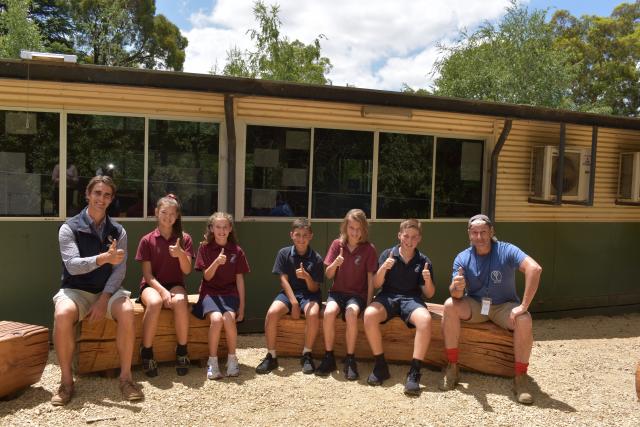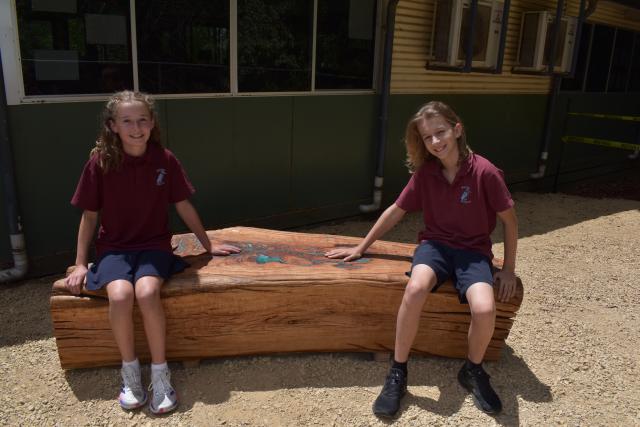
By Callum Ludwig
Throughout recent years, Yarra Ranges residents have braved their fair share of natural disasters, still feeling the effects of weather events like the June 2021 storm and the 2022 floods.
Arborist and Wandin North resident David Ferrier started the ‘Treasuring Our Trees’ project in the aftermath of the June 2021 storm, seeking to salvage fallen timber and one of the first projects is almost finished at Wandin North Primary School (WNPS).
A sustainable bush tucker garden, a yarning circle, a wooden shopfront and ‘fairy houses’ are all soon to open up a new array of learning opportunities for students.
Mr Ferrier said it’s incredibly exciting and the crews working on the project are pinching themselves all the time.
“We’ve been building this for 15 or 16 months, and now we are really at the starting line, though it feels like we’ve run a marathon at this point,” he said
“This is our first of five planned school projects, and we’ve got partnerships now with 18 primary schools, two kindergartens and one, maybe two secondary schools. We’re looking to build a minimum of 20 community projects.”
Treasuring Our Trees crews have worked tirelessly over the last month, working 10-hour days seven days a week to get the new area ready to open up to students.
Work started by laying down 42 tonnes of crushed rock donated by Boral in Coldstream and now, the yarning circle and first of 15 veggie boxes have been installed – one for each class in the school.
Mr Ferrier said the project will continue to help with students’ education around sustainability and its links to the environment as well as climate change and its impact on weather events like storms and floods.
“These events aren’t going away, they are becoming more regular. We understood the power of this program, enriching the school community and greater community through education but also providing this space for the children to learn about growing their own food and being more sustainable,” he said.
“I’ve personally been impacted by the flood event last year living in Wandin North and I’ve seen the damage from the floods on impacted properties throughout this area and up in the hills as well and the children and families are watching what’s happening up in New South Wales and Northern Victoria.”
In December 2022, the Treasuring Our Trees program opened a showroom in Lilydale to act as an educational hub, as well as a processing site in Pakenham Upper which stores thousands of trees and enables the charity to continue its operations.
The relationship between David Ferrier and Wandin North Primary School came about in the immediate aftermath of the June 2021 storm, with the school forced into closure as large trees had fallen across the car parking area. Mr Ferrier offered his assistance to clear the fallen trees.
Wandin North Primary School Principal Paul Bailey said it was amazing that out of his own time, Mr Ferrier came to help clean up the area and made sure it was safe.
“From then it was a relationship that continued to grow, once Dave and his team had the idea of Treasuring Our Trees, the partnership naturally developed. The timber has a story to tell and we want to empower our children to know that story,” he said.
“We’re a school that in the last couple of years has been beginning to teach sustainability and environmental sciences, but now this year, it’s really going full steam ahead with one of our teachers taking that on board. Schools have the best opportunity to plant the seeds with the children to then continue the conversation at home.”
As well as schools across the Yarra Ranges, Treasuring Our Trees has worked with Yarra Ranges and Cardinia Council, Emergency Recovery Victoria, Melbourne Water, Rotary and the Victorian Government to help recover trees and now give them a second life.
Mr Ferrier said he is very privileged to be in a position supported by an amazing board and greater community.
“We have probably up to 50 people who support the work, with the construction and everything that leads up to it, but to be honest, we’re really trying to build an innovative pilot program,” he said.
“There’s no reason why this couldn’t be replicated in communities right around Australia after natural disasters. That’s one of the biggest strongest messages we are trying to share.”







